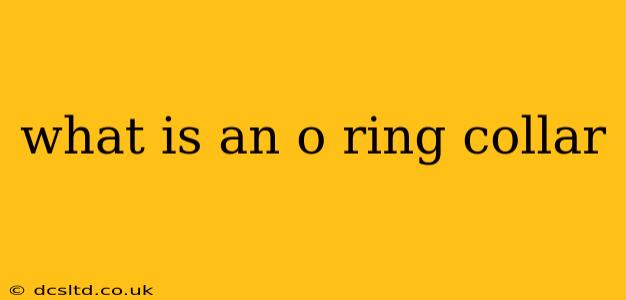An O-ring collar, also known as an O-ring groove, is a crucial component in various applications requiring a reliable seal. It's essentially a groove or channel machined into a fitting, housing, or other mechanical part to accommodate an O-ring. The O-ring, a toroidal (doughnut-shaped) elastomeric seal, sits within this groove, creating a pressure-tight seal between two mating surfaces. This simple yet effective design prevents leakage of liquids, gases, or even dust, maintaining pressure and preventing contamination. Understanding the function and applications of O-ring collars is key to successful engineering and maintenance in many industries.
What are the Different Types of O-Ring Collars?
O-ring collars aren't a standardized part in terms of shape and material. The design depends on the application and the specific needs of the system. However, we can categorize them based on a few key factors:
-
Material: The material of the collar itself will vary greatly depending on the application's environment. Common materials include metals (steel, aluminum, brass), plastics (polymers like PTFE), and even ceramics, depending on the temperature, pressure, and chemical compatibility requirements.
-
Shape and Size: The shape of the groove is crucial for proper O-ring installation and sealing. The dimensions of the groove—its width and depth—are precisely engineered to accommodate the specific O-ring size, ensuring a secure fit and preventing the O-ring from being compressed excessively or insufficiently. These dimensions are often specified according to industry standards (like ASME B16.20).
-
Configuration: Some collars might incorporate features beyond a simple groove, such as:
- Back-up rings: These secondary rings provide additional support for the O-ring, preventing extrusion under high pressure.
- Land areas: These are flat surfaces adjacent to the groove, providing additional contact area and support for the O-ring.
- Multiple grooves: Some applications may require multiple O-rings for enhanced sealing, requiring multiple grooves.
What are the Common Applications of O-Ring Collars?
The versatility of O-ring collars makes them ubiquitous in various industries. Their ability to create a reliable seal in diverse environments makes them an essential component in:
-
Hydraulic and Pneumatic Systems: O-ring collars are fundamental in sealing hydraulic cylinders, pneumatic actuators, and other fluid power components, preventing leaks and ensuring efficient operation.
-
Automotive Industry: From engine seals to transmission components, O-rings are extensively used to maintain pressure and prevent leaks in various automotive systems.
-
Aerospace Industry: Given the critical nature of sealing in aircraft and spacecraft, O-ring collars are employed to ensure the integrity of fuel lines, hydraulic systems, and other crucial components.
-
Chemical Processing: In industries dealing with corrosive or hazardous substances, specialized materials are used for both the O-rings and collars to ensure chemical compatibility and prevent leakage.
-
Medical Devices: O-ring collars find applications in medical devices requiring precise sealing, ensuring the safety and functionality of equipment.
How to Choose the Right O-Ring Collar?
Selecting the correct O-ring collar involves careful consideration of several factors:
-
Operating Pressure and Temperature: The collar and O-ring materials must be compatible with the expected pressure and temperature ranges to prevent failure or leakage.
-
Fluid Compatibility: If the system involves fluids, ensure that the O-ring and collar materials are resistant to chemical attack or degradation.
-
Required Seal Life: The design and materials should be selected to provide the required seal life for the application.
-
Space Constraints: The available space and the size of the mating components will influence the selection of the O-ring and the dimensions of the collar.
What is the Difference Between an O-Ring and an O-Ring Collar?
It’s crucial to understand the distinction: the O-ring is the elastomeric seal itself, while the O-ring collar is the groove or channel that houses the O-ring. The collar provides the structural support and precise positioning for the O-ring, ensuring a reliable seal is created. They are interdependent components; the O-ring cannot function effectively without a properly designed collar.
What Materials are Used for O-Ring Collars?
The materials used for O-ring collars are highly dependent on the specific application and its environmental demands. These include, but are not limited to:
- Steel: Offers high strength and durability, suitable for high-pressure applications.
- Aluminum: Lighter than steel, but still relatively strong, often preferred where weight is a concern.
- Brass: Provides good corrosion resistance, making it suitable for many applications.
- Plastics (e.g., PTFE): Offer excellent chemical resistance and are often used in aggressive environments.
- Ceramics: Used in high-temperature or highly corrosive environments where other materials would fail.
This guide offers a comprehensive overview of O-ring collars. Remember to always consult with engineering specifications and industry standards for the proper selection and installation of these critical components.
